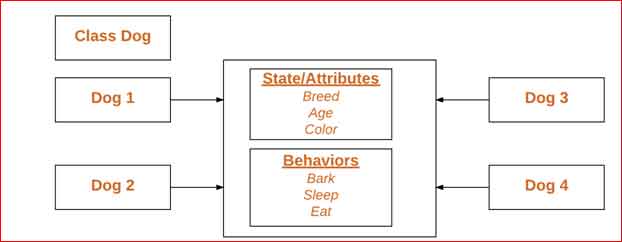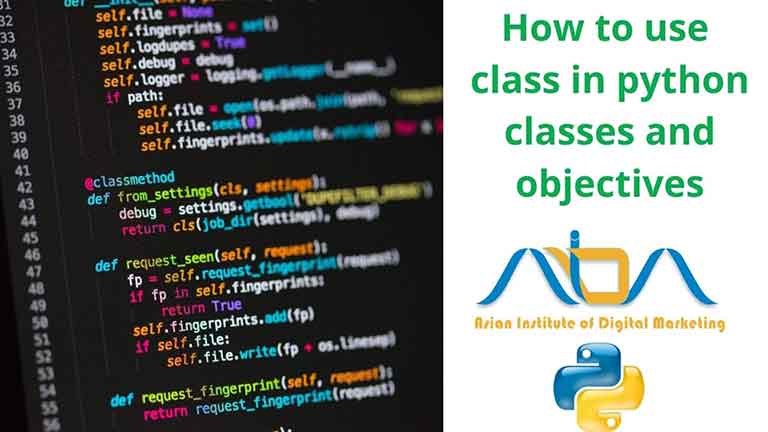Post Contents
This is another post of our python for beginners series based on python classes and objectives. This series is running under the guidance of our expert faculties. We are one of the leading python training institutes in Laxmi Nagar Delhi, which is continuously providing the best training to the candidates and helping in achieving their dreams of getting a decent job.
Let’s dive in deep knowledge!
Python class
A class is a user-defined blueprint or model from which objects are made. Classes give a method for bundling data and usefulness together. Making another class makes another kind of article, permitting new cases of that type to be made. Each class case can have attributes connected to it for keeping up its state. Class occurrences can likewise have strategies (defined by its class) for altering its state.
To comprehend the requirement for making a class how about we think about an example, suppose you needed to follow the number of dogs which may have various attributes like breed, age. If the list is utilized, the principal component could be the canine’s breed while the subsequent component could speak to its age. How about we assume there are 100 unique dogs, at that point how might you know which component should be which? Imagine a scenario in which you needed to add different properties to these dogs. This needs association and it’s the specific requirement for classes.
The class makes a user-defined data structure, which holds its own data individuals and part works, which can be gotten to and utilized by making a case of that class. A class resembles a blueprint for an object.
Grow in your python career and get the desired job by joining the best python course in Delhi.
This example of class keywords shows that the class is created and followed by the name of the class (In this case, we have used DOG as a class)
Some important points on python class:
Classes are formed by keyword class.
Attributes are those variables, which belong to the class.
Attributes are vissible and it can be accessed by using (.) operator like Myclass.Myattribute
Class Definition Syntax:
class ClassName:
# Statement-1 .
# Statement-N
# Python program to
# demonstrate defining
# a class
class Dog:
pass
This example of class keywords shows that the class is created and followed by the name of the class (In this case, we have used DOG as a class)
It will be good if you learn Data Science course in delhi yourself by joining the Django training in delhi
Class object
An Object is an occasion of a Class. A class resembles a blueprint while a case is a duplicate of the class with real qualities. It is anything but thought any longer, it’s a real canine, similar to a canine of breed pug who’s seven years of age. You can have numerous dogs to make various occurrences, however without the class as a guide, you would be lost, not recognizing what data is required.
An object may have the following properties:
State: It is represented by attributes of an object, which also showcase the properties of an object.
Behaviour: It is represented by the methods of an object and reflects the output of the object with other objects.
Identity: It provides a unique name to an object and allows one object to interact with other objects.
For online and offline classes of python, you can enrol yourself in the best python course in Laxmi Nagar
Object declaration
An Object is an occasion of a Class. A class resembles a blueprint while a case is a duplicate of the class with real qualities. It is anything but thought any longer, it’s a real canine, similar to a canine of breed pug who’s seven years of age. You can have numerous dogs to make various occurrences, however without the class as a guide, you would be lost, not recognizing what data is required.

# Python program to
# demonstrate instantiating
# a class
class Dog:
# A simple class
# attribute
attr1 = “mamal”
attr2 = “dog”
# A sample method
def fun(self):
print(“I’m a”, self.attr1)
print(“I’m a”, self.attr2)
# Driver code
# Object instantiation
Rodger = Dog()
# Accessing class attributes
# and method through objects
print(Rodger.attr1)
Rodger.fun()
Output:
mamal
I’m a mamal
I’m a dog
This example shows that an object is created based on a Dog named Rodger. It has two class attributes that represent that Rodger is a Dog and a mammal.
The Self
- The class must have an extra parameter while defining it. When we call a method, we do not require to give a value for this parameter, python itself provides it.
- If We have a method without arguments, then still we have to have one argument.
- This is all similar to the pointer in C++ and reference in Java.
When we call a method of an object, we write myobject.method (arg1, arg2), which is automatically converted by the default setting of python programming language into MyClass.method (myobject,arg1, arg2).
Join our online & offline java training institute in delhi and android app development course for beginners to become an expert in this field.
__init__ method
The __init__ technique is like constructors in C++ and Java. Constructors are utilized to introduce the object’s state. Like strategies, a constructor additionally contains a collection of statements(i.e. instructions) that are executed at the hour of Object creation. It is run when an object of a class is started up. The technique is helpful to do any initialization that you need to do with your object.
AIDM, a python institute in Delhi is providing the advance course to the candidates who want to enhance their career as a python developer.
# A Sample class with init method
class Person:
# init method or constructor
def __init__(self, name):
self.name = name
# Sample Method
def say_hi(self):
print(‘Hello, my name is’, self.name)
p = Person(‘Nikhil’)
p.say_hi()
Output:
Hello, my name is Nikhil
Instance factors are for data one of a kind to each instance and class factors are for attributes and techniques shared by all instances of the class. Instance factors are factors whose worth is appointed inside a constructor or strategy with self though class factors are factors whose worth is allocated in the class.
It will be good if you learn php training in Delhi yourself by artificial intelligence course in delhi.
Instance variable with constructor
# Python program to represent the variables with a value
# assigned in the class while declaration, which is class variables and
# variables in the methods and constructors are instance
# variables.
# Class for Dog
class Dog:
# Class Variable
animal = ‘dog’
# The init method or constructor
def __init__(self, breed, color):
# Instance Variable
self.breed = breed
self.color = color
# Objects of Dog class
Rodger = Dog(“Pug”, “brown”)
Buzo = Dog(“Bulldog”, “black”)
print(‘Rodger details:’)
print(‘Rodger is a’, Rodger.animal)
print(‘Breed: ‘, Rodger.breed)
print(‘Color: ‘, Rodger.color)
print(‘\nBuzo details:’)
print(‘Buzo is a’, Buzo.animal)
print(‘Breed: ‘, Buzo.breed)
print(‘Color: ‘, Buzo.color)
# Class variables can be accessed using class
# name also
print(“\nAccessing class variable using class name”)
print(Dog.animal)
Output:
Rodger details:
Rodger is a dog
Breed: Pug
Colour: brown
Buzo details:
Buzo is a dog
Breed: Bulldog
Colour: black
Accessing class variable using a class name
Dog This is all about python classes, objectives and their uses. If you are still hungry to know about in deep, you can join our python course in Laxmi Nagar and boost your concepts.
Recommended Blog:
- Number system, random module, math library, decimal in the python programming language
- Variable and datatypes work and behaviours in python language
- Python setup and a basic understanding of python language
- How to use casting and string in python
- Use of Boolean Datatype and Python Operators
- Use case of the tuple in python difference between list and tuple
- Python Sets And Dictionaries Python Lists, Python Sets & Dictionary
- Difference Between For and While Loop In Python
- What Are The 3 Types Of Loops In Python For Loop In Python With Condition







